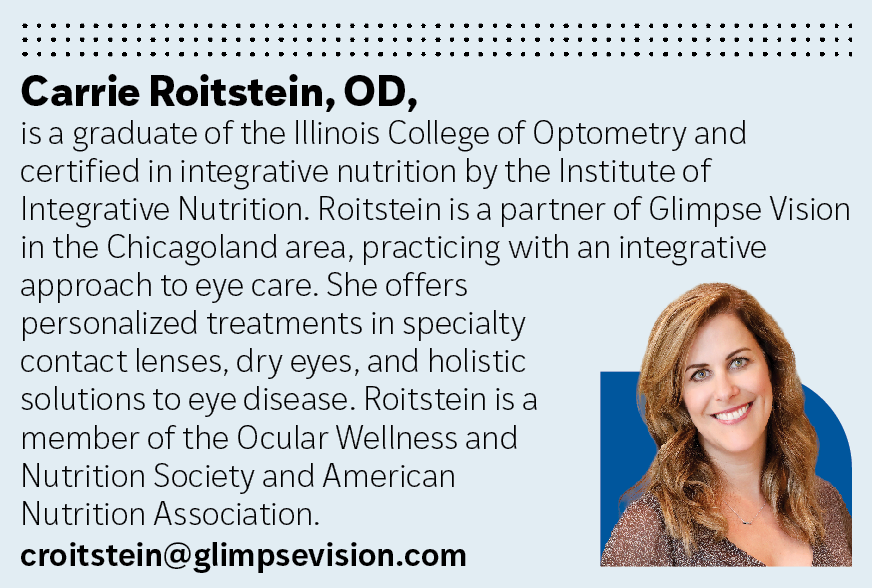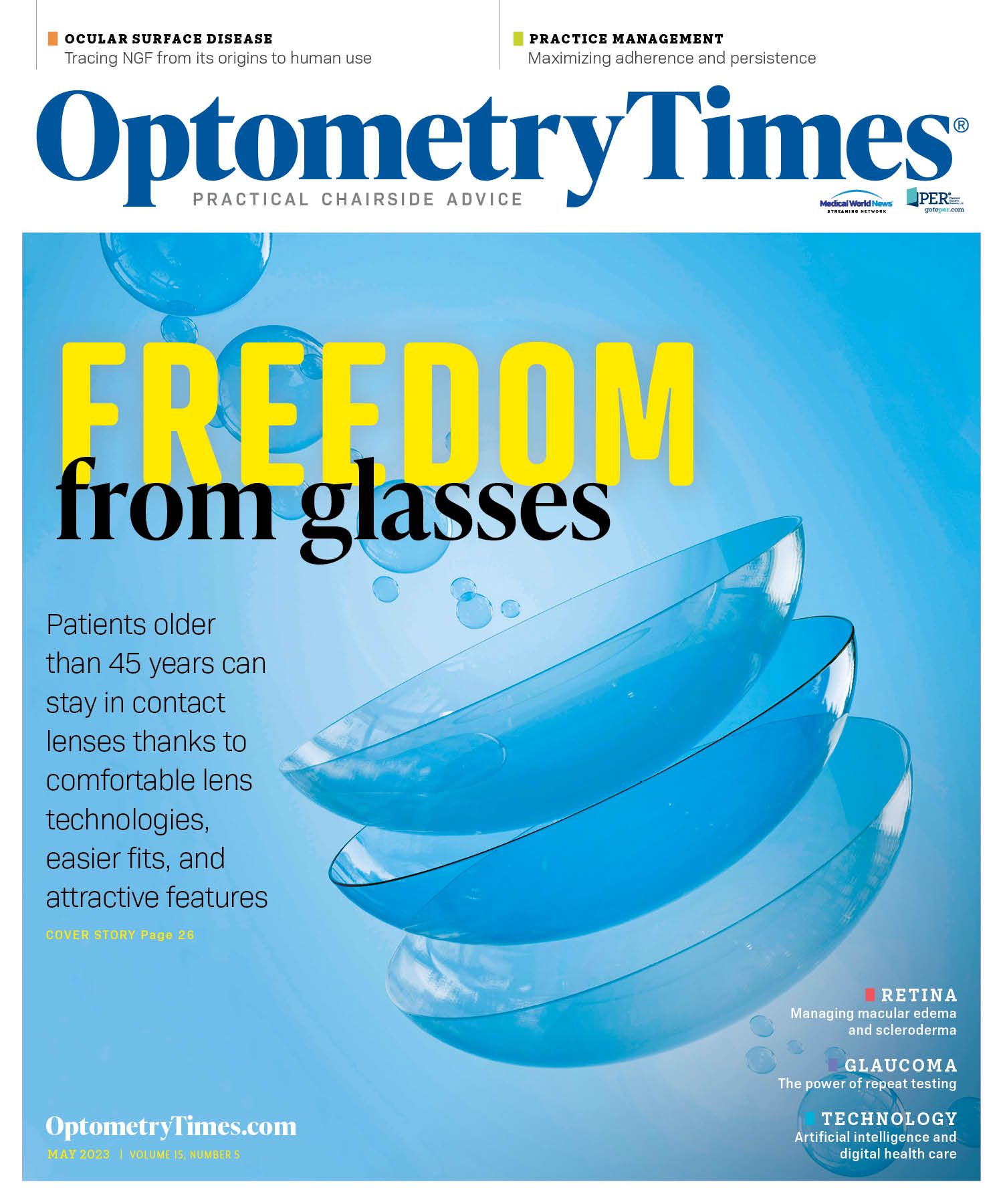Wellness-driven optometrists represent a new generation of eye care professionals
A holistic approach provides better eye care for patients.
What will optometry look like in the next year? In the next 5 years? In the next decade?
Holistic health awareness has been a topic of conversation further sparked by the pandemic. As eye care professionals, we can make an impact on the way patients view wellness and eye care in relation to everyday lifestyle habits. Those connections are extremely rewarding. (Adobe Stock/maglara)

Over the years, optometric care has proudly grown from primarily providing vision correction to solving and preventing problems in all aspects of eye health. As health care continues to evolve, it challenges us to think more proactively vs reactively. Patients have become more interested in making informed decisions about health outcomes and preventive treatment plans. We must continue to make the connection between vision and health while incorporating measures for patient education and disease prevention.
Health history reimagined
Today, each patient enters the office with concerns originating from disease or lifestyle and deserves personalized care, a type of medical care in which treatment is customized for an individual patient. This care may result in a vision correction, dry eye treatment, or referral for additional testing beyond our scope of treatment. However, to provide the best patient care, we must obtain valuable answers for effective, integrative wellness solutions.
As eye care practitioners, the way we evaluate patients must evolve with current science-based evidence. Screening for the standard health factors of hypertension, medication lists, and contact lens comfort does not completely deliver the information necessary for a comprehensive exam. The current standardized questions of patient screening fall short of inquiring about the following items:
» Water intake
» Cosmetic use
» Eye hygiene
» Sports
» Work demands
» Stress
» Sleep
» Supplement use
How do you approach gathering all this information? One option is to have the patient expound on initial information. For example, if a patient complains of eye strain or eye fatigue, are you asking that patient what type of computer they use, the number of screens they work on, and their working distance? What about lighting at the office—what type and origin? Are they drinking enough water during the day? Could sleep apnea be contributing to eye fatigue? Does this patient have deficiency in any key nutrients that could be causing fatigue? Any or all these factors could contribute to eye fatigue, but many practitioners would only inquire about whether an electronic device is used and recommend a basic lens appropriate for computer use. Let’s challenge the way we think about eye care beyond the standard solution and provide personalized treatment options that empower patients to pursue healthier lifestyles.
The future of eye care
Holistic health awareness has been a topic of conversation further sparked by the pandemic. As eye care professionals, we can make an impact on the way patients view wellness and eye care in relation to everyday lifestyle habits. Those connections are extremely rewarding.
As science advances, we must continuously move forward, integrating medicine into a more holistic space. One way we can do this is by updating the standard electronic medical record or health history form. If we want to start looking at patients holistically, then the intake form should include valuable information such as cosmetic use, nutrition, and sleep patterns, all which can affect eye health and general well-being. Having these answers will allow for a more comprehensive evaluation and personalized treatment plan. Let’s approach a few missing topics when taking a health history.
First, sleep deprivation is a crucial component that can cause dry eyes, affect retina health, and be connected to chronic disease. Many patients cannot honestly answer how many quality hours of sleep they get, let alone whether they snore or have received a diagnosis of sleep apnea. Thus, broaching the sleep topic could determine whether a significant risk factor may exist for eye disease.
Second, we would miss the mark by ignoring the topic of supplements when supplement use is a growing industry. Prior to the pandemic, dietary supplement sales increased by 5% ($345 million) in the United States in 2019 compared with those of the previous year. However, there was a 44% ($435 million) increase in sales in the 6 weeks preceding April 5, 2020.1 We are fortunate that the eye care industry has support from many science-based companies regarding supplement options that address eye disease with great efficacy.
As evidenced in results of many science-based studies, supplement use has been proven effective in preventing the progression of age-related macular degeneration (AMD)2 and dry eye disease.3 In results of both the AREDS2 and DEWS II studies, supplementation has been shown to significantly affect the success of managing chronic eye conditions.
Third, results from other studies have shown a connection between the gut-brain axis and regulation of inflammatory nociception, inflammatory responses, and immune homeostasis.4 Communication axes exist between gut microbiota and the eye. Therefore, knowing how these microbiota influence the host metabolism during aging could guide a better understanding of AMD pathogenesis. One nutritional focus with current data suggests that diets rich in fish, fruits, and vegetables and low in glycemic index are most beneficial to retina health.
Fourth, additional research from the Dry Eye Assessment and Management (DREAM) study5 has shown a link between depression and the severity of dry eyes. Mental health plays a role in chronic eye disease that cannot be overlooked.
Lastly, the negative effect of underregulated toxic ingredients in cosmetics is revealed by study results to cause skin irritation, meibomian gland atrophy,6 endocrine disruption, and other conditions. On December 23, 2022, the US Congress passed the first major amendment to the FDA’s cosmetics authority since 1938 with the Modernization of Cosmetics Regulation Act of 2022.7 This will expand power to regulate certain products, including cosmetics. We should work toward finding the cause of eye conditions rather than managing the symptom.
Providing holistic eye care
As optometrists, we graduate with extensive training for managing vision disorders. We learn about systemic disease, trauma, and genetics that can lead to vision loss. But what if we guide our patients through conversations about steps to prevent eye disease?
These discussions do not have to be complicated. In fact, they are practice builders and referral sources. You do not have to be an expert in nutrition or functional medicine to discuss preventive measures for a future of healthy vision. Here are some recommendations and action items for a more integrative, personalized patient experience:
» More outdoor activity and reduced screen time
» Increased movement
» Eating colorful foods rich in carotenoids
» Getting quality sleep
» Preservative-free eye products
» Supplements for qualified patients
» Tools to research product ingredients
» Referrals for further testing
Manage each case with bio-individuality (meaning there is not a one-size-fits-all solution to health issues) while encouraging patients to make better choices for living a healthy lifestyle. Use this as an opportunity to work with and establish networks with other practitioners. You will learn that many patients already work with a nutritionist, health coach, or functional medicine doctor. These connections between medical modalities are invaluable and will only benefit the patient to detect the underlying cause of their issue, possibly uncovering more than meets the eye.
As an optometrist with a certification in integrative nutrition, I strive to push the medical profession to make a shift toward preventive holistic care. We must use the time we have with patients to leave them with a new piece of shared wisdom, regardless of which medical modality you practice. It only takes 1 small change to begin a healthy formed habit. We aim for a patient to have a unique experience to share with a friend or family member or as an online review.
A simple way to manage your time with patients is to create educational brochures or email links you can share during an examination. You may also choose to reappoint time later for further testing based on examination findings. Additionally, you can network with other medical modalities to refer patients for further evaluation and treatment.

The wellness industry is growing, so optometry should be actively taking part in this exciting shift in medicine. We live in an ever-changing world, one in which medicine advances daily. With internet access, patients are more educated than ever and want to be more involved in treatment plans. So with patient care in mind, it is our responsibility to evolve, educate, and change patterns in an ongoing effort to create healthy communities. It doesn’t take expert knowledge to be part of these industry changes that can bring positive results to patient care.
References
1. Lordan R. Dietary supplements and nutraceuticals market growth during the coronavirus pandemic - implications for consumers and regulatory oversight. PharmaNutrition. 2021;18:100282. doi:10.1016/j.phanu.2021.100282
2. Age-related eye disease studies (AREDS/AREDS2). National Eye Institute. https://www.nei.nih.gov/research/clinical-trials/age-related-eye-disease-studies-aredsareds2 Accessed April 19, 2023.
3. TFOS DEWS II - management and therapy. Tear Film & Ocular Surface Society. 2011. http://www.tfosdewsreport.org/report-management_and_therapy/147_36/en/ Accessed April 19, 2023
4. Agirman G, Yu KB, Hsiao EY. Signaling inflammation across the gut-brain axis. Science. 2021;374(6571):1087-1092. Doi:10.1126/science.abi6087
5. Zhou Y, Murrough J, Yu Y, et al; DREAM Study Research Group. Association between depression and severity of dry eye symptoms, signs, and inflammatory markers in the DREAM Study. JAMA Ophthalmol. 2022;140(4):392-399. Doi:10.1001/jamaophthalmol.2022.0140
6. Wang J, Liu Y, Kam WR, Li Y, Sullivan DA. Toxicity of the cosmetic preservatives parabens, phenoxyethanol and chlorphenesin on human meibomian gland epithelial cells. Exp Eye Res. 2020;196:108057. Doi:10.1016/j.exer.2020.108057
7. Consolidated Appropriations Act, HR 2617, 117th Cong (2021-2022). https://www.congress.gov/bill/117th-congress/house-bill/2617?q=%257B%2522search%2522:%255B%2522Consolidated+Appropriations+Act+2023%2522%255D%257D&s=9&r=16 Accessed April 19, 2023.

Newsletter
Want more insights like this? Subscribe to Optometry Times and get clinical pearls and practice tips delivered straight to your inbox.